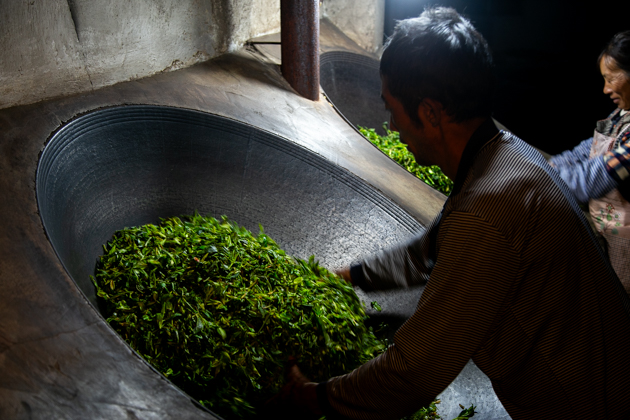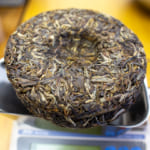- HOME >
- Origin of Tea
Yunnan 2024 Spring Tea Sourcing
- [2024.04.10] Posted By Akira Hojo

Yunnan Province is globally renowned for the exceptional quality of its tea leaves. However, lax production management often presents challenges in achieving the desired tea quality when relying solely on pre-made teas. To address this issue, we have committed to remaining on-site throughout the spring season to closely monitor tea production. We are meticulously inspecting tea gardens to ensure they meet our standards regarding the growing environment of tea trees and tea processing methods. Additionally, we are vigilantly monitoring daily weather changes to manage production conditions effectively. Our goal is to collaborate with tea makers to produce the finest quality tea.
Although we anticipated that teas from old tea trees would be ready for plucking from April onwards, we arrived in Yunnan in March, before the peak tea plucking season begins. This early arrival allows us to survey the conditions of the tea gardens before finalizing which ones are suitable for our teas.
First and foremost, it is crucial to ensure that the tea gardens are in a natural farming state and are independent, without neighbouring plantations of other agricultural products such as maize or walnuts. This precaution is necessary because pesticides or herbicides are commonly used on these neighbouring crops, posing a high risk of contamination. Therefore, we must identify specific gardens and make advance arrangements for tea pluckers to collect fresh tea leaves only from the gardens we have approved.
Currently, our plan is to stay in Yunnan Province until May.

The tea of 2024 boasts exceptional quality
This year, in the Lincang region, there has been significantly less rainfall since last December, resulting in overall dry conditions. Consequently, the tea plants have been growing slowly, indicating a high-quality year for tea production.
During the last week of March, we experienced almost daily evening showers, providing just the right amount of moisture to the tea trees. As a result, starting from April, tea in the area at around 2000m elevation has begun to reach its picking season simultaneously. However, it’s worth noting that tea trees aged around 300 years and above have a much slower growth rate, and their harvesting is expected to commence towards the end of this month or the beginning of May, even at the same elevation.

The tea season begins with white tea production
From March to mid-April, the weather tends to be relatively cooler with lower ambient temperatures, making it ideal for white tea production. At present, we are fully immersed in producing white tea. The quality of white tea is significantly influenced by the weather. In the event of poor weather conditions, such as cloudy or rainy days, we employ various methods, such as using fans, to ensure proper ventilation; otherwise, the tea may develop a musty odour. The optimal period for producing high-quality white tea is quite limited, and we consider this week to be crucial for our endeavours in this regard.


Revising the processing method for raw pu-erh tea.
Regarding raw pu-erh tea, our intention is to collect tea leaves from older tea trees in the higher-elevation tea gardens, which will be ready for plucking starting next week. However, before that, we are currently revising the pan-frying method. This adjustment is necessary due to the processing parameters becoming erratic during the COVID period. As teas from excellent gardens such as Ming Feng Shan, Tang Jia, and Da Cha Lin become ready for plucking next week, our goal is to stabilize the pan-frying method by then.


Experimenting with tea processing methods to enable small-scale farmers to produce black tea.
This year, we are also venturing into black tea experimentation. While the Yunnan black teas we typically source are crafted by specialized black tea producers, I am keen on exploring the development of black tea using the same raw materials employed for Pu-erh tea and white tea. To achieve this, we aim to implement a more straightforward tea-making method that even small-scale farmers can utilize, capitalizing on their abundant resources of old tea trees and existing facilities. Building upon parameters used in the traditional black tea production method prevalent in Yunnan, we are refining the process to enhance the cup characteristics of the black tea in terms of flavor and taste. Hopefully, we may be able to produce black tea with a robust, distinctive aftertaste akin to that of Pu-erh tea. However, we are still in the process of achieving this goal.
Related Articles
How to get the latest update on HOJO?
1. Follow Twitter, 2. Click "Like" on Facebook, and 3. Subscribe in newsletter. You can have the latest tea news from HOJO.
 Subscribe the Newsletter to enjoy the privileges
Subscribe the Newsletter to enjoy the privileges- You may receive a free sample upon purchase, or you may have the priority to purchase special products. So please remember to subscribe our newsletter as well as the social network.
- New Arrival of Akitsu Mumyoi and Nosaka Rough Clay Teapot
- A wide selection of teaware by Watanabe Tozo, a Sado-based artist of Mumyoi-yaki, has just arrived. This time, …
- Mang Fei Ripe Pu-erh Tea 2023 – Small-Batch Production from a Renowned Region
- Mang Fei Ripe Pu-erh Tea 2023 is now available. This is one of the highest-quality ripe pu-erh teas among our …
NEW ARTICLES
 Development of Firewood Roasted Hojicha Using Naturally Grown Tea from Yunnan
Development of Firewood Roasted Hojicha Using Naturally Grown Tea from Yunnan- We are currently staying in Yunnan Province for tea production. As the season nears its end, tea trees with pa …
 Exploring the Food Culture of Yunnan: Where Minority and Sichuan Cuisines Meet
Exploring the Food Culture of Yunnan: Where Minority and Sichuan Cuisines Meet- We are currently staying long-term in Yunnan Province for spring tea production. On rainy days or when there i …
 New Arrival of Akitsu Mumyoi and Nosaka Rough Clay Teapot
New Arrival of Akitsu Mumyoi and Nosaka Rough Clay Teapot- A wide selection of teaware by Watanabe Tozo, a Sado-based artist of Mumyoi-yaki, has just arrived. This time, …
 Managing Yunnan White Tea — Insights from the Field
Managing Yunnan White Tea — Insights from the Field- Since March 25, we have been in Yunnan Province, fully engaged in the production of white tea. In this column, …
 Mang Fei Ripe Pu-erh Tea 2023 – Small-Batch Production from a Renowned Region
Mang Fei Ripe Pu-erh Tea 2023 – Small-Batch Production from a Renowned Region- Mang Fei Ripe Pu-erh Tea 2023 is now available. This is one of the highest-quality ripe pu-erh teas among our …
 Yunnan Tea Trends 2025: Insights from the Fields
Yunnan Tea Trends 2025: Insights from the Fields- Since March 25, we have been in Yunnan Province. We will stay here until May to conduct tea production, packin …
 Why Do Some Teas Taste Astringent? Exploring the Causes and Mechanisms of Astringency
Why Do Some Teas Taste Astringent? Exploring the Causes and Mechanisms of Astringency- Tea can range from having no noticeable astringency to possessing a very strong one. What causes this astringe …
 The Impact of Heat Sources on Tea Flavor
The Impact of Heat Sources on Tea Flavor- It is widely recognized that the material of a kettle plays an important role in shaping the taste of water fo …
 New Release of Tang Li Shan Ripe Pu-erh Tea 2023
New Release of Tang Li Shan Ripe Pu-erh Tea 2023- We have released the 2023 edition of Tang Li Shan Ripe Pu-erh Tea. Tang Li Shan refers to a mountain located o …
 The New Release of Dong Shan Raw Pu-erh Tea 2023 and Jasmine Silver Needle
The New Release of Dong Shan Raw Pu-erh Tea 2023 and Jasmine Silver Needle- We have released Dong Shan Raw Pu-erh Tea 2023 and Jasmine Silver Needle. Dong Shan Raw Pu-erh Tea 2023 We hav …
Category
- New Arrival at HOJO Online Shop
- Featured Articles
- Newsletter
- Types of Tea
- Origin of Tea
- Teapot and Tea Equipment
- Tea Column
- How to enjoy tea
- Tea Processing
- How to choose quality tea
- Tea constituents and functional effect
- Safety of Tea
- Foods
- Tea Business Operation
- Hobby and Outdoor Activity
- Ranking of Tea
- Video
- FAQ
- Media Release
Profile

- AKIRA HOJO
- I invite you to experience my tea selections.I was born in Nagano, Japan. In university, I studied agricultural chemistry, and I have the master degree in food science. I worked in Japanese food industry for 10 years. I involved in R&D, QC and QA. As a factory manager, I implemented ISO9000 series and managed the factory.
- The Art of Tea Magazine
- We posted the article on “The Art of Tea Magazine No.9, the magazine is published in Taiwan. We featured …
- New Straits Times
- The Malaysian National Newspaper, New Straits Times featured HOJO Tea on 17-Oct-2007.
Shop Info

Address:Lot No. T-215, 3rd Floor, The Gardens Mall, Mid Valley City, Lingkaran Syed Putra, 59200 Kuala Lumpur
Tel: +603-2287-4537
Business Hour: 10am to 10pm














